This post may contain affiliate links. We may receive a small commission, at no cost to you, if you make a purchase. Read Disclosure.
Exploring Thailand is relatively easy, but its easy to get overwhelmed by the numbers of options when it comes to getting around.
Depending on where you are in Thailand, you may choose a unique and traditional mode of transportation, like ride-shares, taxis or local buses, as well as songthaews.
In big cities like Bangkok, you will find the chaotic driving overwhelming, so you may decide the metro or BTS sky train to be a safer and less stressful option.

Needless to say, there are many options of public transport when getting around Thailand. In this guide, we’ll introduce you to each transportation option and when you would use them.
How to Get Around in Thailand?
Whether you’re looking for an adventurous mode of transport or you want something simple, these are the best ways to get around Thailand…
Tuk tuks
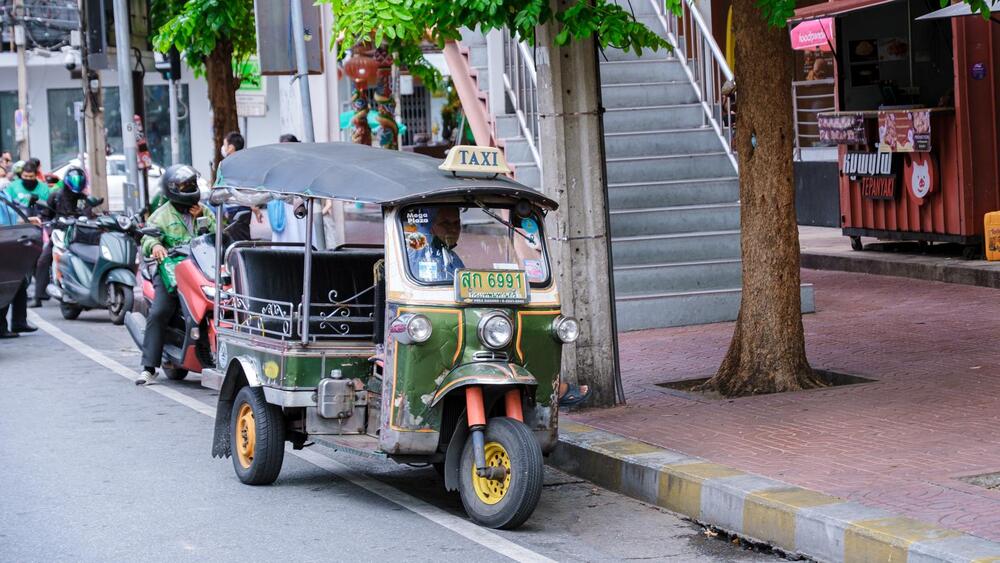
When my partner, Brent, and I first arrived in Thailand, it seemed like we were having nothing but bad luck when it came to taking tuk-tuks.
The drivers were constantly trying to charge us outrageous prices, leading us off on unwanted detours, and attempting to short-change us at the end of the ride.
Brent was filling one of our Thai co-workers in on the latest of our disaster stories, and the explanation for our woes seemed quite simple to her: “Because tuk-tuks are for tourists.”
Once she pointed this out, it seemed obvious: I never see Thai people riding around in tuk-tuks.
Tuk-tuks can be fun, but as a means for travel, they are not the best option. Not only are they expensive but they can be a bit of a scam in terms of what you get for the price.
In my experience, most businesses in Thailand will unabashedly charge foreigners more than they charge locals.
Therefore, chances are, if you’re traveling like a foreign tourist, you’re probably getting charged like one too. If you want to get around Thailand on a budget, you need to learn how to travel like a Thai person, not a tourist.
Unless you want to ride in a tuk tuk for the ride itself, we don’t recommend it.
Scooters
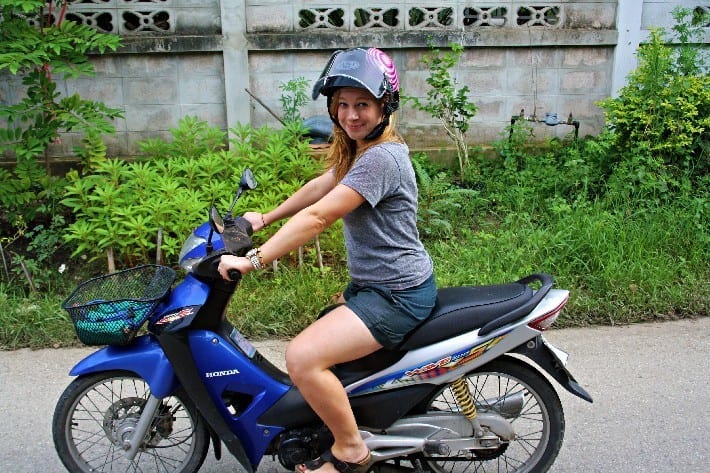
Almost everyone owns motorbikes or a scooter in Thailand. It’s therefore no surprise that, by far, the cheapest and easiest way to get around in any Thai city is to rent your own scooter or motorcycle.
For about $5 per day, a scooter rental gives you the freedom to go where you want, when you want. That said, not everyone is comfortable on a scooter, and traffic in some cities isn’t suited to newbies.
For those who don’t want to rent their own, scooter taxis are a good alternative which you can order on Grab or Bolt. Scooter taxis are easily recognizable because the drivers typically wear a brightly coloured vest.
They are as quick as tuk-tuks, but in my experience, the drivers are less likely to overcharge. In fact, in smaller towns the drivers often charge a low flat rate to travel anywhere within the city.
Fair warning, many scooter rentals ask for your passport as a deposit or a large fee in cash. Always choose the cash!
You technically need an international driver’s license to rent a scooter in Thailand, but as long as you have a driver’s license you should be fine. And there are police check points, so if you have no license don’t risk it.
Songthaews
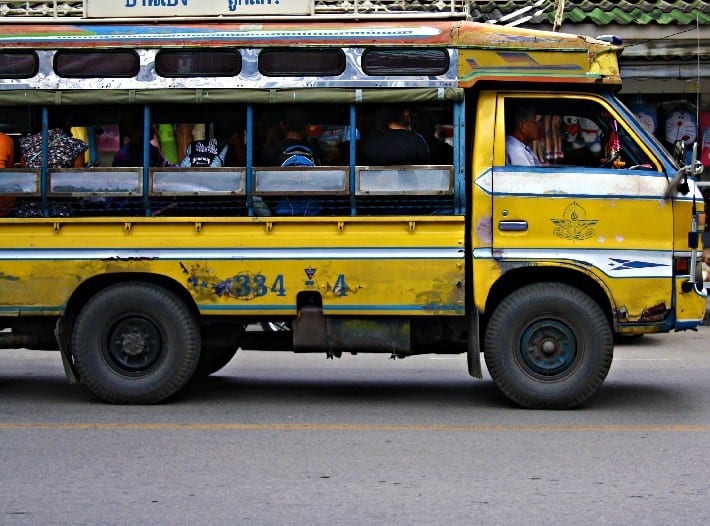
These look like open pick-ups trucks with parallel benches in the back. They run within cities like a local bus, or on short routes between nearby cities.
There’s no official “stop” for songthaews, so you just stand by the side of the road and flag one down as it passes. They’re usually quite colourful, and full of people, making it easy to see them coming up the street. Hop inside the back, and then pay the driver when you get off.
Typically, you’ll be charged a set fare to ride to anywhere along the songthaew’s route.
Meter Taxis & Ride-Share Apps

If you’re carrying a lot of baggage, scooters and songthaews may not be practical options. In this case, I recommend meter taxis, or yellow taxis, over tuk-tuks.
If you ask the driver to run the meter for your trip, you almost always end up paying less than if you try to haggle over a fare with a tuk-tuk driver.
Nowadays, it’s easier and more cost effective to use ride-share apps such as Grab and Bolt, which are the Asian versions of Uber.
You can also order yellow taxis on these apps, but the good thing is the price is agreed beforehand and you can pay through the app, so no need to worry about counting your cash to make sure you have enough money.
Metro or BTS

When in Bangkok, it can be overwhelming navigating its bustling streets, though this becomes a breeze with the efficient and convenient Metro and BTS systems.
The Metro, known as the MRT, covers major areas like Sukhumvit, Silom, and Chatuchak Market, whisking you away to popular shopping destinations and cultural landmarks.
The BTS Skytrain stretches across both elevated and underground tracks, offering stunning views of the city skyline while effortlessly taking you to places like Siam Paragon, Terminal 21, and Chao Phraya River.
With air-conditioned carriages and frequent train arrivals, the Metro and BTS are a comfortable and reliable way to explore Bangkok.
Long-Distance Bus

Traveling long distances by bus in Thailand is not only affordable but also a convenient way to explore the country.
Thailand has an extensive bus network, which allows you to reach practically anywhere in Thailand by bus.
Despite its previous poor reputation, bus travel in Thailand has undergone significant improvements, offering more comfort and reliability.
VIP buses are especially popular for long-haul journeys, providing a comfortable and sometimes even luxurious experience with WiFi, free bottles of water and snacks.
You can get from Bangkok to popular destinations like Krabi or Phuket, buses offer budget-friendly options for travelers.
Night Train
Taking a night train in Thailand is a memorable experience. The most popular route is between Bangkok and Chiang Mai, and is yet another affordable way to travel.
These sleeper trains provide comfortable accommodations, allowing passengers to rest in cozy berths during the journey. If you want to travel super budget, you can opt for a third-class seat which is a seat rather than a bunk.
But even first-class tickets are cheap.
Whether you choose a lower or upper berth, the night train promises an adventure filled with comfort, convenience, and breathtaking scenery.
Internal Flights

Taking domestic flights in Thailand is another convenient and efficient way to get from A to B. With several budget airlines offering domestic flights, including Thai Airways, Bangkok Airways, Nok Air, Thai Lion Air, Thai Smile, and Thai Air Asia, travelers have plenty of options to choose from.
These airlines operate from major airport hubs like Bangkok, Chiang Mai, Phuket, Krabi, and Koh Samui, ensuring easy connectivity to popular destinations.
Internal flights in Thailand are known for their affordability, making it a cost-effective option for travelers, but you do need to book in advance to get a good deal.
Long Tail Boats

Taking longtail boats is a unique and authentic way to explore the country’s stunning waterways and coastal areas.
Longtail boats, also known as reua hang yao, are traditional wooden boats with long propeller shafts, making them distinctively Thai.
They are not only used for touristy rides but also serve as ferries, cargo boats, and transportation between islands.
Whether you’re island hopping, getting from Ao Nang to Railay Beach, exploring the Bangkok klongs (canals), or simply enjoying a leisurely cruise along the Andaman Sea, longtail boats provide a charming and immersive experience.
You can also do border crossings between Thailand and Laos on a long tail boat, which is a unique experience.
Ferries

Ferries are one of the best ways to get to the islands in Thailand. With numerous ferry routes connecting places like Koh Samui, Koh Phangan, Koh Tao, Koh Lanta, Koh Phi Phi Islands, Phuket, and Krabi, travelers have plenty of options to choose from.
Ferry travel in Thailand is generally considered safe, though it can be slow.
Various ferry companies, such as Lomprayah, Raja Ferry Port, and Seatran Ferry, operate reliable services.
Tickets can be easily booked through platforms like 12Go.asia or from the ticket counters at the port.
Tips for Navigating Public Transport in Thailand
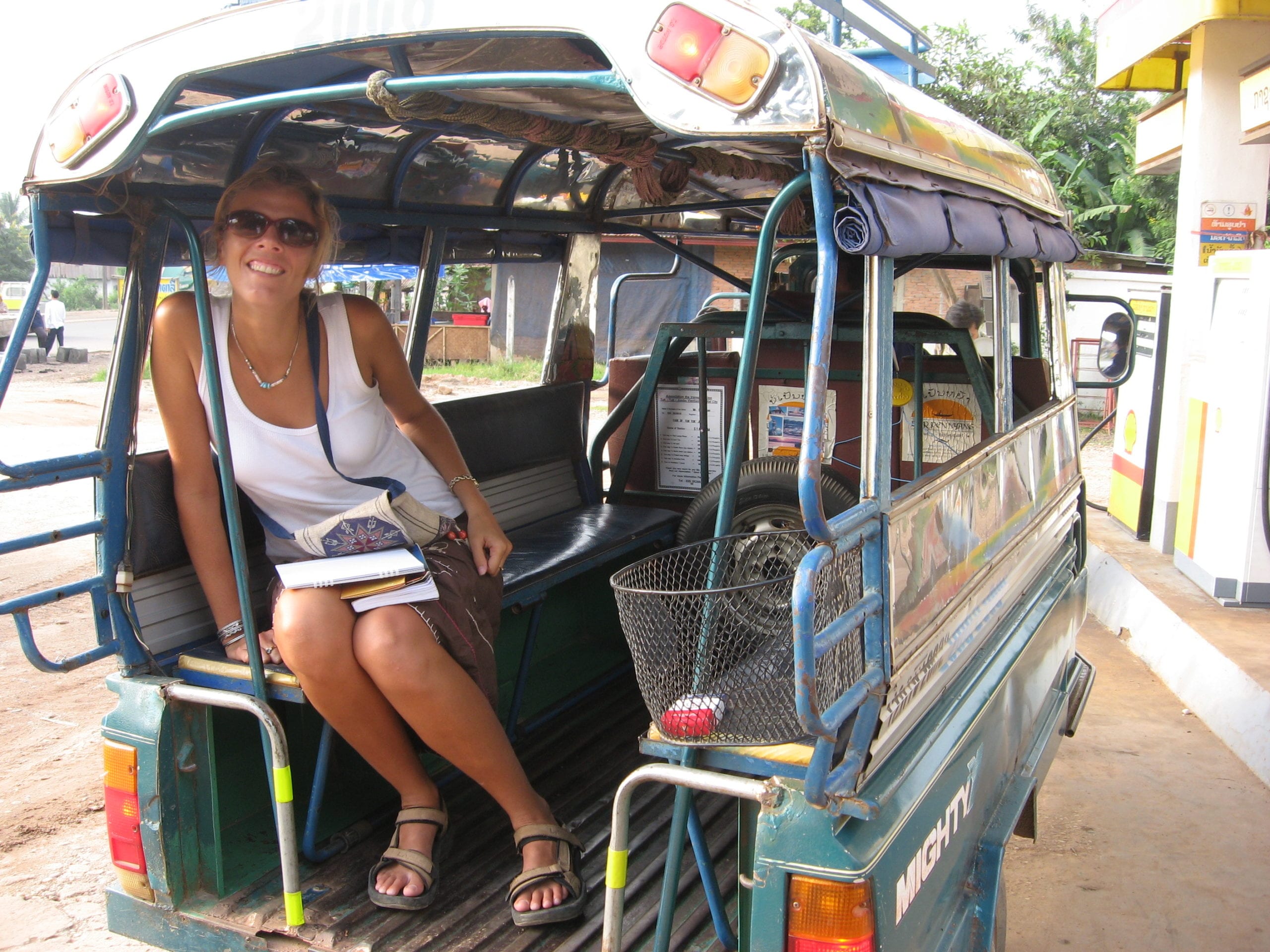
To make sure you are able to get around Thailand with ease, here are some words of advice…
It doesn’t take a lot of effort to learn how to say “hello”, “thank you”, and “how are you?” in Thai, but it makes a world of difference in how you’re treated. (“Sawadee,” “Kop Kuhn,” “Sabadee mai?”- respectively)
If you show your driver that you speak a little Thai, you will seem less like a wide-eyed tourist who just got off the plane, ready to fall for anything. Trying to make some taxi conversation helps the driver see you as a person, rather than just another dumb foreigner.
The use of a few polite phrases in Thai almost always leads to a better price and a shorter route. For example, once during a meter taxi ride, our driver suggested that he take us to the nearest metro stop, because the rush hour traffic was going to make the ride to our destination unusually expensive.
He could easily have kept driving and not warned us, leaving us to pay the inflated fare. I can’t be sure, but I think he gave us a break because he was charmed by our broken attempts at Thai. A little Thai also goes a long way towards getting a warmer reception and more assistance at bus and train stations.
Learn to Love Slow, Unpredictable Transit
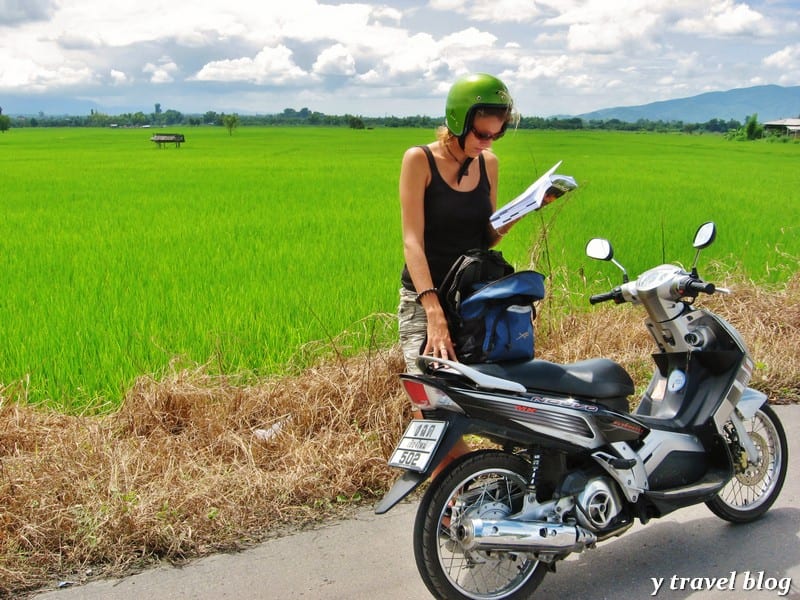
I’ve had to get used to the fact that it’s very difficult to make plans around transport between cities and provinces in Thailand. It’s not always possible to find bus and train timetables online, let alone book a seat in advance. Trains and buses are frequently very late, slow, and crowded.
Buying a ticket doesn’t mean that you won’t end up squatting in the aisle because all of the seats are taken. Getting around in Thailand became a lot easier for me once I stopped worrying about when I was going to get to my destination.
The craziness of the transport system becomes more manageable when you view it as an adventure, rather than a hassle. There’s something strangely magical about a long, slow ride on the rickety Thai railway, with the windows open to combat the sweaty heat, listening to the vendors calling out for passengers to buy food as they walk up and down the aisles.
When you stop taking transport seriously, you can start to enjoy the journey and have some fun figuring out the best ways to get around Thailand.
More helpful posts on Thailand
- Guide to Planning a Trip to Thailand with Kids
- 3-Day Bangok Itinerary: The Best of Bangkok In 2023
- The Ultimate 5 Day Phuket Itinerary for 2023
- 23 Helpful Tips for Traveling to Thailand with Kids
BIO: Jessica has been working/volunteering her way through Europe and Southeast Asia with her partner, Brent, since September 2011. The projects are varied: from gardening at a retreat center in Germany to teaching ESL in Thailand. Check out Ways of Wanderers for her latest stories and travel advice.